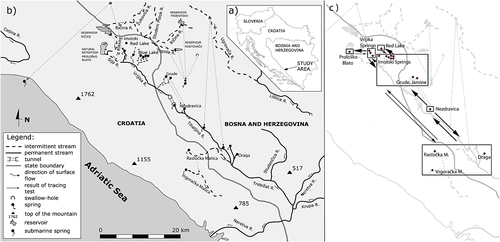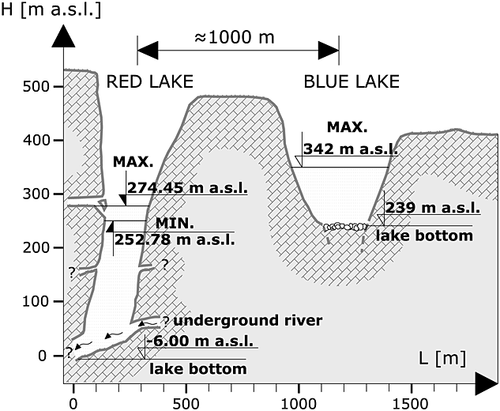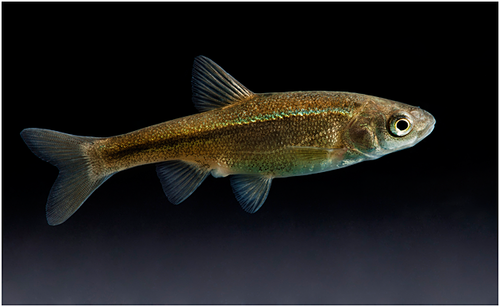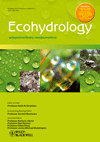Molecular data as a possible tool for tracing groundwater flow in karst environment: example of Delminichthys adspersus in Dinaric karst system
ABSTRACT
Karst areas have some of the most complex aquifers in the world. Because of extreme groundwater oscillations, different hydrological connections are active depending on the season. Therefore, the complex water network remains poorly investigated, despite many geological, hydrological and geomorphological studies performed. The methodology of water tracing was developed especially to determine water interconnections in karst. In addition to tracing with salt, dye or temperature, the use of rich endemic fauna, their dispersion and population structure is lately considered. In this paper, we used population structure of endemic fish species Delminichthys adspersus to confirm hydrological data as well as suggest new underground water connections in part of central Dinaric karst. Moreover, we propose a holistic approach of karst area studies, combining hydrology with biology to develop a better strategy for the protection of vulnerable karst ecosystems. Copyright © 2011 John Wiley & Sons, Ltd.
INTRODUCTION
Karst is a type of landscape with many different surface and underground features, which facilitate and accelerate the exchange of ground and surface water, resulting in a complex and unpredictable aquifer (Bonacci et al., 2009). The unpredictability is due to extreme oscillations of groundwater levels (more than 200 m) that cover a large temporal range from minutes to decades and enable various possibilities of water flow in neighbouring parts of karst systems. Determining water circulation is crucial for explaining hydrological and hydrogeological processes and their influence on resident biota. The interconnections of water sources also add to the vulnerability of the flora and fauna, because pollution of apparently isolated springs can lead to extensive consequences (Bonacci, 1995; Bonacci and Roje-Bonacci, 2000).
Heterogeneous karst landscape creates a variety of aquatic and terrestrial habitats, which are, because of their inaccessibility, one of the least known ecosystems on the planet, giving home to often endemic and endangered species (Culver and Sket, 2000; Pipan and Culver, 2007; Deharveng et al., 2009). For the survival of permanent or occasional karst inhabitants, water transport of suspended sediment and organic materials, food, (micro) organisms, seeds, eggs and contaminants from surface to underground and vice versa is of great importance. Resident fish species are no exception. Their population structure and physiological activity (food sources, reproduction) is highly influenced by a variety of hydrological characteristics. The challenging environment of temporal karst springs and underground streams supplies a frame for different possibilities of adaptation. For instance, some populations of freshwater fish species of Central and North American karst areas, such as Astyanax fasciatus, Cottus carolinae and Forbesichthys (Chologaster) agassizi, evolved in stygobionts (obligates in subterranean groundwater and cave streams), losing their eyes and pigmentation, yet retaining the ability to interbreed with surface-dwelling populations (Romero and Paulson, 2001; Strecker et al., 2004; Kinziger et al., 2007). In Dinaric karst, endemic fish species with a vernacular name ‘gaovice’ evolved to actively follow the withdrawing water of the intermittent springs and periodically occupy the subterranean environment, which provides them long-term shelter during dry periods. These minnow-like fish belong to three distinctive lineages, Telestes, Phoxinellus and Delminichthys (Cyprinidae), and inhabit small karstic basins in Croatia and in Bosnia and Herzegovina (Bogutskaya and Zupančič, 2003; Freyhof et al., 2006; Palandačić et al., 2010; Perea et al., 2010). There were some indications in the literature suggesting ‘gaovice’ can migrate underground. For instance, Telestes croaticus is known to populate Ličko polje but was also found in the springs of Gatsko polje (Zupančič, 2008), whereas Bonacci (2008) gave proof of hydrological links between Lika and Gacka Rivers. Inspired by such presumptions along with our own field observations, we employed a population genetic study on several superficially isolated populations of D. adspersus, and using this approach provided the first molecular evidence of underground dispersal of the studied fish (Palandačić, 2012).
The main objective of this paper is to establish whether the genetic data, acquired from different geographically separated populations of ‘gaovice’, are comparable with hydrological measurements and therefore can be used to infer underground water connections. Moreover, we aim to assess the suitability of aquatic organisms as possible biological tracers of groundwater flow. Finally, we tend to cut across the boundaries of hydrology and biology and propose an example of synergistic supplementation of karst hydrology and population genetics expertise in an attempt to study underground water system in the central part of Dinaric karst.
TRACING AND TRACERS – A NECESSARY TOOL FOR DETERMINATION OF POSSIBLE CONNECTIONS IN KARST MASSIF
Sinking, losing and underground karst streams as well as swallow holes and springs play a crucial role in hydrology and ecology of karst systems (Yuan, 1991; Ray, 2005; Bonacci, 2010). The connections between different parts of karst systems and the position of the karst catchment boundaries depend upon the rapidly fluctuating groundwater levels. When groundwater level is extremely high, the fossil and inactive underground karst conduits become functional, causing the redistribution of catchment areas, that is, overflow from one to the other catchment. Hydrogeological conditions can change in a very short time as a consequence of natural (precipitation) or anthropogenic influences (building of dams and reservoirs, inter-basin water transfer, etc.). For investigation of this complex conduit organization, water-tracing techniques are very useful.
Tracing tests provide information on the inaccessible and unexplored underground parts of karst systems (Goldscheider et al., 2008). They are generally regarded as being the most reliable and efficient means of gathering karst subsurface hydraulic information (Field, 1999). Goldscheider (2005) considers tracer tests in combination with other geological and hydrological observations as the most powerful method for delineating the catchment areas in karst, which is of great importance in scientific disciplines such as geology, hydrology, chemistry, physics, water management, biology and limnology (Käs, 1998). Tracing tests can be classified according to different criteria (Ford and Williams, 2007): (1) quantitative and (2) qualitative; or (1) artificial labels, (2) particulates, (3) natural labels and (4) pulses. The natural labels are (1) microorganism, (2) ions and solution and (3) environmental isotopes. Smart and Worthington (2004b) classify tracers as (1) physical, (2) chemical, (3) isotopic and (4) biological.
Biological tracers are defined as organisms inadvertently present in the water such as coliform bacteria in the wells (Smart and Worthington, 2004b). However, a possibility of complementing other tracing techniques with more systematized use of biological tracers is lately considered. Whereas Smart and Worthington (2004a) only speculate about the dispersion of organisms via underground water connections, Pipan and Culver (2007) make more concrete suggestion to apply biological findings in hydrology by using rich epikarstic fauna as possible water tracers. Because the biological tracers are natural and already present in the system, there is no need for the introduction of possibly harmful tracers that disrupt the environment (dye, salt). Besides quantitative measurements, biological tracers also give qualitative information about the type of water connection and its suitability for dispersion of organisms. Already 70 years ago, Hawes (1939) recognized important ecological effects of hydrological processes (floods) in karst, which operate as distribution agents of species and help maintain a regular food supply of the underground. However, a concrete attempt to link biological data with findings of other tracer techniques has to our knowledge not yet been presented.
STUDY AREA
The study area, shown in Figure 1, is located in Croatia and in Bosnia and Herzegovina between 43°10′ and 43°60′N and 17°10′ and 17°60′E in the central part of bare and deep Dinaric karst region.

The climate of the area represents a combination of the Mediterranean and continental climates, because it is separated from the Adriatic Sea by the Biokovo mountain chain with maximum altitude of 1762 m a. s. l. The average annual air temperature varies from under 10 (northern higher part) to 14 °C (southern lower part) with a minimum daily temperature in January below −10 °C and a maximum daily temperature in July and August over 35 °C. The annual rainfall ranges from 750 to 2350 mm with a 1500 mm average. The maximum rainfall occurs in October and November and the minimum in July and August. The groundwater levels oscillate with maximum amplitude of more than 130 m, with the maximum intensities up to 3 m per hour after heavy rains in October and November (Bonacci, 1987; Bonacci and Roje-Bonacci, 2008). The predominant rocks in the area are carbonate limestones with some dolomites of Tertiary and Cretaceous formations, which do not obstruct groundwater circulation considerably.
More than 100 temporary and permanent karst springs emerge along the longer axes of the karst poljes (fields), forming temporary or permanent stream flows. Despite abundant precipitation, most of the streams in the area are intermittent (or sinking), going underground at the end of a field and emerging on another. D. adspersus is present in about 10% of the springs in the area (personal observation).
Figure 2 presents cross section through two exceptional karst phenomena from the study area – Red Lake and Blue Lake (Bonacci, 2006). Bögli (1980) and Williams (2004) describe Red Lake as the deepest known case of a collapse dolina containing a permanent lake. Garašić (1999) speleohydrogeological expedition has found an active underground river that crosses the lake at its bottom, 6 m below the Adriatic Sea level. Detailed speleological investigations confirmed that the lake is connected directly to two karst conduits through which water constantly flows in and out from the upper to the lower part of the karst aquifer (Figure 2). Less than 1000 m far from Red Lake lays Blue Lake, which dries up approximately every 5 years. The water-level fluctuations in both lakes follow the groundwater level oscillations in the surrounding aquifers and are larger than indicated in Figure 2 (Bonacci and Roje-Bonacci, 2008).

The results of tracing test performed in the study area are given in Figure 1, including several subterranean connections proven to exist by dye or physical tracers (Kanaet, 1961), for instance, from Grudsko Vrijelo to the Tihaljina River some 30 km downstream from the river source, between the sinkholes of the Rastočka Matica and the sources of Vrgoračka Matica, while a strong indication of subterranean connection between Red Lake and Spring Jažva in the village of Glavina Donja was also suggested (Bonacci, 2006). Moreover, discrepancy in temperature and water quantity of the sinking Vrljika River and springing Tihaljina River was reported indicating that not only the Vrljika but also other subterranean water streams must be involved in building up the Tihaljina River system (Kanaet, 1961).
Because of extremely complex surface and underground karst morphology of the study area, numerous geological, hydrogeological and hydrological investigations (Bonacci and Roje-Bonacci, 2000) were insufficient to define either the catchment boundaries of karst springs and rivers or the directions of groundwater flow in different hydrological situations.
USE OF DELMINICHTHYS ADSPERSUS AS TRACERS
Delminichthys adspersus (Heckel, 1843), Cyprinidae (Figure 3), is the most abundant representative of the genus Delminichthys. The distribution range of D. adspersus stretches from the village Vinjani in the north of Imotsko polje to the coastal town of Ploče in the south, including Red Lake (type locality) and many direct and indirect springs of the Ričina and Vrljika Rivers as well as other springs connected with the rivers Matica, Tihaljina, Trebižat and Lakes of Bačina (Zupančič, 2008). The species' small distribution (Figure 1) is endangered as a result of reduction and destruction of karst environment by agricultural pollution and watercourse regulation, the general lack of public awareness and occasional occurrences of overfishing by local inhabitants. The species is listed as vulnerable on the International Union for Conservation of Nature Red List of Threatened Species (Mrakovčić et al., 2006).

The population genetic structure of D. adspersus was determined using molecular methods based on deoxyribonucleic acid (DNA). DNA in the cell is partitioned between the nucleus and two other sub-compartments, mitochondria and chloroplasts. Whereas chloroplasts are only present in plants and in some algae, mitochondria are components of almost all eukaryotic cells. Despite very effective cell mechanisms that provide DNA maintenance and repair, errors may nevertheless occur during DNA replication. Such errors (DNA mutations) give rise to abundant number of genetic variants (called alleles in diploid DNA and haplotypes in haploid DNA), which can be used in assessing genetic differentiation between individuals, populations, species and so forth. From studying genetic change, one can infer evolutionary history (phylogeny) of organisms or study evolutionary processes of populations such as natural selection, genetic drift, mutation and migration (gene flow).
Mitochondrial DNA (mtDNA) is a small circular molecule (15–20 kb), which is in most multicellular organisms inherited only from the mother. It replicates separately and independently from the nuclear DNA, does not recombine and possesses fragments of very different mutational rates, which makes mtDNA convenient model for phylogenetic and phylogeographic studies (for details, see Avise, 2000). In addition, mtDNA has the potential to reveal geographic clusters and demographic expansions (Moritz et al., 1987); therefore, we used a rapidly evolving segment of mtDNA, cytochrome b gene, to obtain some basic information about the population structure of D. adspersus. First, haplotype network (distribution of allelic variants in the sample set) was built on the basis of phylogenetic tree constructed with TrN model of sequence evolution (Tamura and Nei, 1993) and the maximum-likelihood method implemented in PAUP* 4·0 (Swofford, 2003). Subsequently, population differentiation was determined by calculating the net sequence divergences between sampling locations using Φ-statistics (Wright 1978) and hierarchical nested analysis of molecular variance both performed with Arlequin (Excoffier, 2007).
However, to study the genetic structure of D. adspersus more precisely, we applied bi-parentally inherited nuclear DNA (nDNA) markers, which accumulate more mutations and therefore give more detailed information about population characteristics. We used microsatellites, that is, stretches of nDNA composed of tandem repeats [e.g. (GAC)n, for details, see Goldstein and Schlötterer, 1999], which have proven as one of fastest-evolving DNA sections. Closely related individuals generally differ in number of tandem repeats (DNA fingerprinting), which represents the basis for inferring an array of population genetic parameters. To determine genetically homogenous groups among the sampled material and to test if these groups exchange their genes or not (i.e. if migration occurs between them), we analysed data by using different approaches and methods. First, traditional FST analysis was used for pairwise population comparisons (Arlequin, Excoffier, 2007) followed by creating a population tree on the basis of allele sharing distances with the software Populations (Chakraborty and Jin, 2004). Because FST-based methods have been criticized a lot (Jost, 2008), the most probable number of groups in the sample set was determined also with Bayesian methods implemented in software Structure (Pritchard et al. 2000; Falush et al. 2003; Falush et al. 2007; Hubisz et al. 2009) and BAPS (Corander et al. 2003; Corander and Marttinen 2006; Corander et al. 2006; Corander et al. 2008), which instead of averaging over the information from the markers, determine patterns of population structure with combining information from multiple markers into a single probability model. Finally, combined data set of mitochondrial and nuclear DNA was used to estimate how many fish (if any) migrate and in which direction. For this purpose, Markov chain Monte Carlo-based software IMa2 (Hey and Nielsen, 2007), which determines migration rates, was applied to the data set. In addition, the number of fish migrating in the last generation was assessed using software Geneclass2 (Piry et al., 2004).
All the methods used in this study were in details described in Palandačić (2012). Here, we give a comprehensible methodological overview in order to illuminate the main principles of the applied molecular approach.
The results of molecular analysis revealed complex population structure. Analysis of mtDNA cytochrome b discovered no completely isolated populations, thus indicating connectivity between sampling locations. Microsatellite analysis revealed genetic similarity between the fish from Red Lake and Vrljika river system and between Vrljika and Tihaljina river systems, which are all geographically (physically) isolated. More specifically, FST-based analysis revealed six groups, which almost completely correspond to geographic division presented in Table 1. It confirmed that fish from sampling locations Vrgoračka Matica, Rastočka Matica and Draga form one, uniform population and also revealed genetically similar unit composed of the fish from seven Imotski springs and two springs from Grude. Bayesian approaches confirmed unity of the two groups and further detected similarities between Prološko Blato and Imotski +Grude Springs as well as between Red Lake and Imotski +Grude Springs. Finally, IMa2 detected migration of fish among all of the six proposed groups, except between Vrljika Springs and Red Lake, and from Nezdravica to the Imotski + Grude Springs. The fact that migration is recent (detection of individual migration in the last generation) was confirmed also using Geneclass2. Detailed results including the direction and migration rates are given in Figure 1c.
| Genetically defined group | Number of sampling sites | Description |
|---|---|---|
| Prološko Blato | 1 | Natural retention |
| Vrljika Springs | 3 | Vrljika River is supplied with several springs; three of them sampled in this study turned out to be same population |
| Red Lake | 1 | See Figure 2 |
| Imotski Springs | 7 | Several springs emerge in the town of Imotski and in its close vicinity, most of them being temporal. As inferred from genetic analysis, fish of these springs mix freely with those of Grudsko Vrijelo and Jamine despite considerable geographic distance and were therefore unified within the same group |
| Grudsko Vrijelo, Jamine | 2 | Two springs in Hercegovina belonging to the Vrljika river system. Whereas Grudsko Vrijelo is permanent, Jamine is active only during high rainfall |
| Nezdravica | 1 | A left tributary to Tihaljina River in Herzegovina, containing high concentrations of magnesium salts. It is populated with the most isolated and genetically particular population of Delminichthys adspersus |
| Rastočka, Vrgoračka Matica and Draga | 3 | Molecular results pointed to a physical connection between the rivers Rastočka Matica and Vrgoračka Matica even though there are no direct surface connections between them. Brook Draga was on the basis of molecular analysis also assigned to this group |
The described molecular data and specific configuration of the studied area, which physically prevent surface communication between many genetically similar populations (Palandačić et al., in submission), as well as the adaptation of D. adspersus to long-term subterranean dwelling (Mrakovčić et al., 2006) represent persuasive evidence that D. adspersus migrate underground and use this particular behaviour to maintain the species gene flow. Considering these notions, we believe that migration patterns of D. adspersus faithfully reflect several underground water connections and thus justify their potential role as a biological groundwater tracer.
DISCUSSION
In the present study, we aimed to compare hydrological findings with biological ones to confirm known water connections and add qualitative information about the types of connections. Underground gene flow was suggested between most evidently surface-separated locations: (1) Red Lake and the spring of Jažva (Imotski Springs, Table 1), (2) the rivers Vrgoračka and Rastočka Matica and (3) Vrljika and Tihaljina River systems. The underground water ways between the three location pairs have been proven using hydrological measurements and water tracers: in his review, Bonacci (2006) cited several authors who mention an underground canal between Red Lake and Jažva (Cvijić, 1926; Bonacci and Roje-Bonacci, 2000; Garašić, 2001), whereas Kanaet (1961) described water connection between Rastočko and Vrgoračko polje and between Vrljika and Tihaljina River systems determined with dying. Therefore, concordance of biological and hydrological data is evident. Besides corroborating known underground water links, this study also suggests some new ones such as between Imotski and Grude, Vrljika Springs and Prološko Blato as well as Draga and both Matica Rivers. On the other hand, hydrologists provided tracing data for water links between reservoirs Ričice and Tribistvo (Figure 1), which are farther north from the identified range of D. adspersus and Vrljika River. Because these springs were not yet investigated for fish species, further research could be extended to this area.
This study also aims to estimate biological tracers in comparison with physical and chemical ones. In contrast to physical or chemical tracers, fish are live objects with their own energy and instincts and are therefore not simply influenced by environmental physical forces such as water current but are capable of their own mobility. Actually, these are the only tracers that can, to some extent, defy gravity, thereby providing new dimension of tracing subterranean water flows. In karst, low ground and surface waters represent the most common condition throughout a year (more than 80%); this is the period when active and self-driven mobility of the fish is most obvious. Whereas in times of overflow, fish can be either passively carried around by strong currents or hiding from the flood, in the dry season, they swim according to their instincts, thus exhibiting underground water connections that are active during that period. Possibly, this is the case with Imotski and Grude, where fish are completely mixed, indicating that they migrate between them most part of the year rather than on isolated occasions of overflow. In addition, fish need a certain amount of room to be able to swim through; therefore, on the basis of their presence or absence, one can estimate the transition capability of a certain terrain. For instance, Red Lake is a fish residence, from where fish can disperse underground to other springs; on the other hand, the nearby located Blue Lake is fishless, most likely because its porous ground and the fissures appear to represent impassable barrier for fish to enter the lake.
Finally, the intention of this study was to point out the importance of holistic research approaches in karst areas. Because the karst surface aquatic environment and underground water circulation strongly influence the biological functioning of the Delminichthys, closely interrelated researches including population and ecological studies in connection with hydrological findings are crucial for protection of not just the species but whole vulnerable karst underground ecosystems. The new combined method discussed here can be used to create specific vulnerability maps of the area (Goldscheider, 2010) and to aid in protection of often endemic karst fauna, which is an indicator of water quality (Culver, 2001).
CONCLUSION
This paper is an attempt to use biological tracers to better understand the regional water movement in an extremely complex part of the Dinaric karst system. The results indicate that tracing of groundwater flow using molecular data can help in identification of active conduit networks and delineation of catchment areas. Researches of karst areas call for complex interdisciplinary investigations based on detailed monitoring of many different physical, chemical and biological parameters. The proposed tracer technique represent a ‘window’ into the karst underground and makes possible new detailed insight in its hydrological and biological characteristics. This is a typical method of the karst ecohydrology (Bonacci et al., 2009), a new emerging interdisciplinary scientific concept, which will play an active role in better understanding, explanation and sustainable development of karst areas.
ACKNOWLEDGEMENTS
The authors would like to thank all researchers and local inhabitants for their assistance in the field, especially Gašper Pustovrh and Arne Hodalič, who also contributed the amazing photograph of D. adspersus. We would also like to thank Irena Oven for her writing assistance.




